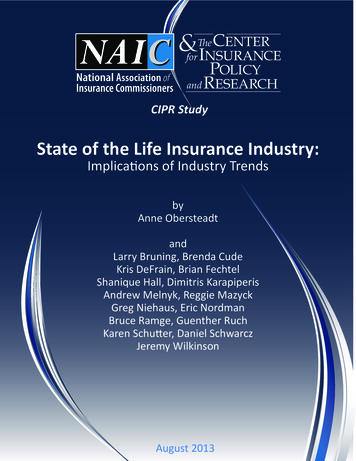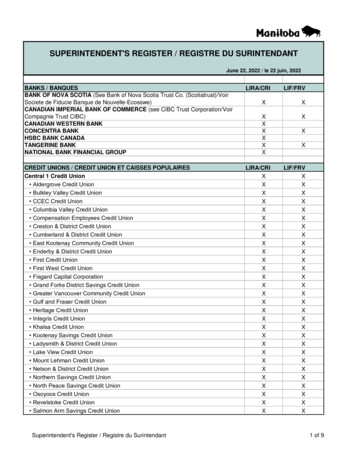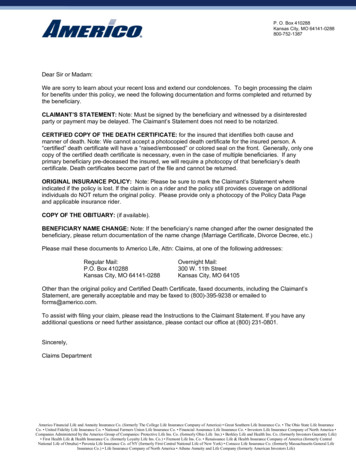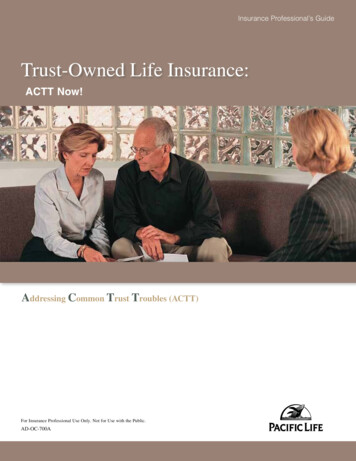
Transcription
CIPR StudyState of the Life Insurance Industry:Implications of Industry TrendsbyAnne ObersteadtandLarry Bruning, Brenda CudeKris DeFrain, Brian FechtelShanique Hall, Dimitris KarapiperisAndrew Melnyk, Reggie MazyckGreg Niehaus, Eric NordmanBruce Ramge, Guenther RuchKaren Schutter, Daniel SchwarczJeremy WilkinsonAugust 2013
State of the Life Insurance Industry:Implications of Industry TrendsByAnne ObersteadtAndLarry BruningBrenda CudeKris DeFrainBrian FechtelShanique HallDimitris KarapiperisAndrew MelnykReggie MazyckGreg NiehausEric NordmanBruce RamgeGuenther RuchKaren SchutterDaniel SchwarczJeremy WilkinsonThis CIPR Study presents research whose purpose is to inform and disseminate ideas to regulators,academics and financial service professionals.The mission for the CIPR is to serve federal and state lawmakers, federal and state regulatoryagencies, international regulatory agencies, and insurance consumers, by enhancingintergovernmental cooperation and awareness, improving consumer protection andpromoting appropriate marketplace competition.Disclaimer: This study represents the opinions of the author(s), and is the product of professionalresearch. It is not meant to represent the position or opinions of the NAIC or its members, nor is it theofficial position of any staff members. Any errors are the fault of the author(s).CIPR Study SĞƌŝĞƐ 2013ͲϬϭDate: August ϮϬϭϯ
NOTE TO READERSThis is the final release of the study in its entirety as one document. This study is organized insix sections, each of which consist of distinct essays by contributing authors, both internal andexternal to the NAIC (NAIC/CIPR staff, state regulators, academics, and industryrepresentatives), covering a broad range of issues having profound and transformativeimplications for the life insurance industry. The sections explore how the industry has evolvedover time, the nature of regulatory responses, the changes in product offerings and technology,and the challenges of the economic environment.The first section, the Evolution of Life Insurance, traces the history of life insurance from the18th century to the present time. The second section, Current and Emerging Product Trends inRetirement and Long-Term Care Markets, discusses how insurers are meeting the increasedneed for retirement products. The third section, The Impact of Technology on the Life InsuranceIndustry, discusses the impact of emerging technologies on the life insurance industry. Thefourth section, Life Insurer Balance Sheets, looks at financial performance of the life insuranceindustry over the last decade and provides an in-depth look at the 2011 numbers to give asnapshot of the industry’s sound financial position today. The fifth section, Implications ofEconomic and Market Changes on Life Insurers, highlights the important role life insurers play inthe economy and covers the impact of the recent global financial crisis on the industry with aspecial focus on the low interest rate environment. The sixth section, Meeting the Risks of theNew Environment, explores risk management in the context of the changing and complexenvironment.i
Authors:Larry Bruning, International Life Actuary, Financial Regulatory Affairs—International, NAICBrenda J. Cude, Professor of Housing and Consumer Economics, University of GeorgiaKris DeFrain, Director, Research and Actuarial Services, NAICBrian Fechtel, CFA, Agent and Founder, Breadwinners’ InsuranceShanique Hall, Manager, CIPR, NAICDimitris Karapiperis, Researcher, CIPR, NAICAndrew Melnyk, Vice President, American Council of Life InsurersReggie Mazyck, Life Actuary, Research and Actuarial Services, NAICGreg Niehaus, Professor of Finance and Insurance, University of South CarolinaEric Nordman, Director, Regulatory Services and CIPR, NAICAnne Obersteadt, Senior Researcher, CIPR, NAICBruce Ramge, Director, Nebraska Department of InsuranceGuenther Ruch, Principal, GHR Consulting, LLC.Karen Schutter, Executive Director, Interstate Insurance Product Regulation CommissionDaniel Schwarcz, Associate Professor, University of Minnesota Law SchoolJeremy Wilkinson, Senior Manager, Communications, NAICAcknowledgements: The authors are grateful to those that reviewed and contributed to thestudy and helped improve it with their insightful comments. Special thanks to former NAIC CEOTerri Vaughan, from whom the concept of this study originated. Additional thanks goes to otherNAIC staff, particularly NAIC COO and CLO Andy Beal; Jennifer Cook, Jolie Mathews, and EthanSonnichsen, Government Relations Office; Dan Daveline, Dave Fleming, Bruce Jensen, JaneKoeningsman, Robin Marcotte, and Todd Sells, NAIC Financial Regulatory Services Department;Randy Helder and Craig Leonard, NAIC Market Regulation Department; Dave Keleher, NAICResearch and Actuarial Services Department; Ed Toy, NAIC Capital Markets Bureau; and PamelaSimpson, NAIC Regulatory Services for her editorial help. The authors also thank NAIC MembersJim Mumford (IA) and Steve Caughill (WI), as well as James W. Schacht (The Schacht Group) fortheir invaluable comments on the draft released at the CIPR Life Insurance Symposium October25, 2012.ii
ContentsExecutive Summary . 1Historical Evolution of Life Insurance . 5Life Insurance Industry in its Infancy . 6Economic Turbulence of the 19th Century . 6State Regulation is Born . 7Life Insurers Dominate the Financial Markets . 8The Armstrong Investigations Restrict Insurers’ Role as Financial Institutions . 8Growth and Confidence Restored Through Regulation and Legislation. 9Life Insurance Sales Soar with the Roaring 1920s. 10The Great Depression Pressures Life Insurers . 10Commercial Banks Repeat Life Insurers’ Mistakes . 11Federal Regulatory Investigations. 12Federal Regulations Reform the Economy. 12Banking Reforms . 13Insurance Reforms . 14Consumer Demand Shifts to Long-Term Security in the Golden Age . 14Consumer Protections. 16Insurers Innovate into Investment-Oriented Products to Keep Pace with High Interest Rates . 16Birth of Universal Insurance and Variable Insurance . 17Variable Annuities . 18High Insurance Lapse Rates Lead to Stronger Insurance Regulations . 21High Interest Rates Spark Deregulation of Financial Institutions . 22The Financial Services Modernization Act . 24Consolidation of the Life Insurance Industry . 25Demutualization . 26Insurance Regulators Respond to the Financial Services Modernization Act. 28The Rise of Derivatives and the Commodity Futures Modernization Act (CFMA) of 2000 . 29Insurers Enter the Twenty-First Century . 30Recession of 2001 . 31Insurers Return to Growth and Core Competencies. 32Insurers Turn to Alternative Funding Mechanisms for Statutory Relief . 32Suitability and Disclosure of Annuities. 33Contingent Commission Practices Investigation . 34Global Financial Crisis. 35iii
Systemic Risk Intervention . 36Lessons Learned from the Financial Crisis . 37Dodd-Frank Wall Street Reform and Consumer Protection Act . 38Solvency Modernization Initiative . 39Current and Emerging Product Trends in Retirement and Long-Term Care Markets . 41Introduction . 42Longevity Risk and Insurance . 44The Growing Need for Retirement Products Provided by Life Insurers . 45Annuities in Pensions . 55Pension Risk Transfer . 58Contingent Deferred Annuities . 61Regulatory Implications of the Risks Inherent in Longevity Products and Transfer Mechanisms . 62The Growing Need for Long-Term Care Insurance . 67Insurance Regulatory Perspectives on Long-Term Care Insurance. 76The Impact of Technology on the Life Insurance Industry. 86Internet and Mobile Technology and the Life Insurance Industry. 87Barriers to Insurers’ Use of the Internet for Product Distribution. 91Implications of Emerging Technology on Insurance Regulation . 94Life Insurer Balance Sheets: Description and Issues of the Past Decade. 99Introduction . 100Framework, Terminology and Data . 102The Life and Health Insurance Industry in 2011 . 104Capital-to-Asset Ratios Vary with Company Size and Line of Business . 110Medium Size Accident and Health Capital-to-Asset Ratios Trend Lower . 113NAIC RBC Ratios: 2001-2011 . 116Changes in Capital During and After the Financial Crisis . 118Conclusions on Life Insurer Balance Sheets . 121Implications of Economic and Market Changes on Life Insurers . 125Insurers’ Place and Key Role in the Economy . 126Impact of Financial Crisis. 127Current Economic and Market Environment . 132The Challenges of the Low Interest Rate Environment . 135How Do Life Insurers Counter Low Interest Rates . 139The Risk of a Spike in Interest Rates . 141NAIC Low Interest Rate Study and Methodology . 142iv
Meeting the Risks of the New Environment . 147Introduction . 148The Importance of Group Supervision . 150The Need for Stronger Corporate Governance . 155The Significance of Enterprise Risk Management . 160Ensuring Capital Adequacy in the New Environment . 163Implications of the Interstate Insurance Product Regulation Commission . 172Opportunities for Better Collaboration between State and Federal Regulators . 173Market Conduct–Better Analytical Tools . 175The Legal Entity Identifier (LEI) Improves Financial Transparency . 181Enhancing Transparency . 182Conclusion . 195References . 199Appendices . 205v
Executive SummaryExecutive Summary1
Executive SummaryForwardInsurance regulation is a dynamic, ever-evolving exercise to achieve an appropriate balancebetween providing adequate consumer protection and allowing the free market to operateunconstrained. Since insurers and the products they offer change over time, it is imperative forthe regulatory framework to keep pace with industry dynamics. This study explores areaswhere the life insurance industry has changed over time through different product offerings,globalization, evolving technology, and changes in the economic environment. Additionally, thestudy examines the regulatory responses to the growing complexity brought about by thesechanges. The study provides a framework to assist regulators in assessing which changes havebeen successful, which need improvement, and what needs to be addressed in the future.Executive SummaryThe study begins with the Evolution of Life Insurance, an examination of how the life insuranceindustry in the United States has evolved over time. The rise of the mutual insurer model iscovered along with early efforts to regulate the industry, including the creation of the NationalAssociation of Insurance Commissioners (NAIC). In the late 19th century large insurersdominated the marketplace and controlled large amounts of money not backed by reserves.They used these funds to purchase controlling shares of banks and other businesses. Theseexcesses led to the 1905 Armstrong investigations in New York. The Armstrong investigationscaused the pendulum to swing toward heavy regulation, with life insurers prohibited fromowning common stock, underwriting securities and paying excessive commissions to agents.Deferred dividend plans also went by the wayside. The pendulum moved back slightly in theearly part of the 20th century, leading to a growth cycle for the life insurance industry. Groupannuities were introduced in the 1920s along with other product innovations. A majorcompetitor in the form of the federal government also found its way into life insurance marketswith the offering of War Risk Insurance to members of the armed forces. Life insurance salesgrew in the 1920s and as a result of the regulatory restrictions stemming from the Armstronginvestigations, life insurers did not suffer to the extent banks did during the stock market crashof 1929.Congress was interested in addressing the causes of the Great Depression. The result was theBanking Act of 1933 (commonly known as Glass-Steagall) that separated commercial banks andinvestment banks from each other and from insurance and investment firms. Insurance reformoccurred in the early 1940s when a U.S. Supreme Court case (U.S. v. Southeastern Underwriters)overturned the long-held opinion (Paul v. Virginia) insurance was not a form of interstatecommerce. Congress enacted the McCarran-Ferguson Act to allow states to continue toregulate and tax the business of insurance despite its new status as a form of interstate2
Executive Summarycommerce. The prosperity following World War II, along with the certainty of governmentprograms such as Social Security, led to a shift in insurance product demand toward productsoffering more long-term investment opportunities. The 1980s saw the introduction of universallife insurance and variable life insurance products. Consolidation and demutualization were thebuzzwords of the day and as a result of the Gramm-Leach-Bliley Act of 1999, banks, insurersand securities firms were once again allowed to affiliate and cross-sell products, and theconcept of functional regulation was introduced. The 1990s through the early 21st century werecharacterized by strong sales and profitability. The Commodities Futures Modernization Act of2000 was adopted. It deregulated over-the-counter-derivatives and allowed financial servicesfirms to invest in a wide variety of derivatives, some of which turned out to be very risky. Inparticular, the introduction of the credit default swap proved to be hazardous to the financialmarkets generally. When combined with the bursting of the housing bubble, the result was theglobal financial crisis of 2007-2008.The study looks at the impact of life insurance product trends in the Current and EmergingProduct Trends in Retirement and Long-Term Care Markets section. There are two key factorsdriving life insurance product development—mortality risk and longevity risk. Traditional lifeinsurance products like term and whole life were intended to address mortality risk—morespecifically, the risk one dies prematurely. Their primary purpose was to provide a safety net forfamilies when one of the primary breadwinners passed away. In recent years, the focus hasshifted to address longevity risk as the baby boomers reach retirement age in a time when thedefined benefit pension plan has become a relic of the past. As the general health of thepopulation improves over time, people are living longer. The blessing of a longer life isaccompanied by the need to generate sufficient income in retirement to be able to enjoy theextra years and pay for long-term care when health status declines. Life insurers areincreasingly targeting product development to meet this need.The Impact of Technology on the Life Insurance Industry section explores how technologicaladvances and consumer preferences are shaping product design and sales. The Internet wasinitially used by insurers to promote their brand and provide some general communications.Increasingly, it is used to recruit insurance producers and actually conduct the business ofinsurance. Access to the Internet using mobile devices is rapidly changing the environmentagain. Insurers are beginning to explore how to use social media such as Facebook and Twitter.Monitoring insurer activity in this emerging area is becoming a challenge for insuranceregulators. The individualization of the social media experience presents many complianceconundrums for insurers and regulators.3
Executive SummaryThe Life Insurer Balance Sheets section looks at the financial performance of the life insuranceindustry over the last decade. As a decade with significant upheaval and economic turmoil, it isa credit to the conservative nature of the life insurance industry and the diligence of insuranceregulators that the life insurance industry significantly outperformed the banking industryduring the decade. The conservative regulatory framework was a major contributing factor tothe success of the industry during the period. An in-depth look at the 2011 numbers is providedto give a snapshot of the industry’s sound financial position today.The Implications of Economic and Market Changes on Life Insurers section discusses how lifeinsurers have responded to the current economic and market volatility. The role life insurersplay with respect to the overall economy is discussed, as is the industry’s role as institutionalinvestors. The section also covers the impact of the recent global financial crisis on the industryand the impact of the low interest rate environment on life insurers.The Meeting the Risks of the New Environment section addresses risk management in the newenvironment. It covers the importance of Enterprise Risk Management (ERM) and the role ofthe new Own Risk Solvency Assessment (ORSA) tool required of many insurers starting in 2015.The influence of the international community is discussed with respect to group supervision.The section also covers market conduct activities of regulators, with an emphasis on newmarket analysis tools being used to target regulatory resources. Regulators use a number oftools to ensure capital adequacy for life insurers. The chapter evaluates the evolution from arules-based to a principle-based regulatory system. The appropriateness of both capital andreserves are covered. Reserving requirements are evaluated to determine whether the ruleslead insurers to establish appropriate reserves for the products being sold. Suggestions forimprovement are included along with a discussion of the role of regulators to improvetransparency through consumer disclosures.4
Historical Evolution of Life InsuranceHistorical Evolution of Life Insurance5
Historical Evolution of Life InsuranceHistorical Evolution of Life InsuranceBy NAIC StaffLife Insurance Industry in its InfancyThe life insurance industry has gone through several periods of transformation, instigated bykey historical events and changes in consumer needs. The Presbyterian Ministers’ Fund,established in 1759, was the first life insurance entity in the United States.1 Although itspurpose was to provide life insurance to the widows and orphans of deceased ministers,negative perceptions surrounding assigning a monetary value to one’s life during this timeperiod stifled growth.2Legal restrictions also presented a barrier to life insurance sales during this time. Many statesbarred women from entering contracts, including insurance policies, or legally inheriting anestate. As such, a wife would not be able to collect proceeds from her husband’s policy.Furthermore, spousal or dependent relationships alone did not meet the monetary insurabilityinterest requirements insurers of this time period required. In addition to limiting who couldtake out an insurance policy, insurers also placed stringent requirements on the activities ofpolicyholders. These requirements usually limited travel to healthier regions of the country,required regular health and character checks and prohibited the consumption of alcohol.3Economic Turbulence of the 19th CenturyComplicating things further was a five-year depression brought on by the Panic of 1837. Landspeculation (driven mostly by western territory sales) fueled by loose credit from state bankshad created a real estate bubble and high inflation.4 In response, President Andrew Jacksonissued the Specie Circular in 1836, limiting payment of land to gold and silver.5 The state bankshad overextended their lending abilities by printing money beyond their reserves, resulting inbank and business failures, real estate losses, and record high unemployment levels.6 These andsimilar sequences of events would play out several times throughout history, including threemore times in the latter part of the 19th century.1Murphy, Sharon. "Life Insurance in the United States through World War I". EH.Net Encyclopedia.[1798-1899], Presbyterian Ministers’ Fund records (Collection 3101), The Historical Society of Pennsylvania. Fromhttp://hsp.org/sites/default/files/legacy Murphy, Sharon. "Life Insurance in the United States through World War I". EH.Net Encyclopedia, edited byRobert Whaples. August 14, 2002. URL urance.us.4McNamara, R. (n.d.). Financial panics of the 19th century. Retrieved a/financialpanics.htm5“Panic of 1837," Ohio History Central, July 1, 2005, http://www.ohiohistorycentral.org/entry.php?rec 536.6Ibid.26
Historical Evolution of Life InsuranceState Regulation is BornInsurers, unable to raise sufficient capital to form as a stock company following the Panic of1837, mutualized instead.7 A mutual company is owned by its policyholders as opposed tostockholders. Mutual insurers have less stringent capital requirements and higher reliance onpremiums from policyholders (also owners) for cash flow. To increase premiums, mutualinsurers launched a very successful marketing campaign promoting ownership benefits,essentially policyholders as owners of the company would share in the company’s profitsthrough dividends or reduced premiums.8The ease of starting up a mutual insurance company, combined with the appeal of policyholderdividends, produced a plethora of new entrants into the marketplace. Eventually the marketbecame saturated and insurers began using fraudulent activities to increase market share. NewYork responded to this fraudulent activity by instituting capital stock (1849) and depository(1851) regulatory requirements.9 New Hampshire appointed an insurance commissioner in1850.10 Massachusetts implemented legal reserve principles, and formed a state insurancedepartment to oversee these new laws (1858).11 Soon other states were following suit, withmost states implementing regulatory oversight of insurers by the early 1870s.12In 1868, the Supreme Court decision in Paul v. Virginia securely placed insurance under thesupervision of states. Soon after, in 1871, the National Insurance Convention (later known asthe National Association of Insurance Commissioners (NAIC)) was formed to address the needto coordinate regulation of multistate insurers. Although the new state regulations slowedindustry growth for the next decade, they also restored consumer confidence. Additionally,legislative changes during this time allowed women access to insurance and institutedconsumer-friendly nonforfeiture laws.13 Stability returned the growth to the United Stateseconomy, which was growing more industrial and prosperous. The resulting rise in demand,coupled with the changes in legislation, insurer structure, and marketing practices, set the stagefor future industry expansion.7Murphy, Sharon. "Life Insurance in the United States through World War I". EH.Net Encyclopedia, edited byRobert Whaples. August 14, 2002. URL urance.us.8Ibid9Ibid10Ibid11Insurance & the U.S. Economy. Best Insurance Education Company. Retrieved L-IUS.pdf.12Poterba, James M., The History of Annuities in the Unit
life insurance and variable life insurance products. Consolidation and demutualization were the buzzwords of the day and as a result of the Gramm-Leach-Bliley Act of 1999, banks, insurers and securities firms were once again allowed to affiliate and cross-sell products, and the concept of functional regulation was introduced.











